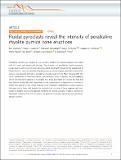Files in this item
Fluidal pyroclasts reveal the intensity of peralkaline rhyolite pumice cone eruptions
Item metadata
| dc.contributor.author | Clarke, Ben | |
| dc.contributor.author | Calder, Eliza S. | |
| dc.contributor.author | Dessalegn, Firawalin | |
| dc.contributor.author | Fontijn, Karen | |
| dc.contributor.author | Cortés, Joaquín A. | |
| dc.contributor.author | Naylor, Mark | |
| dc.contributor.author | Butler, Ian | |
| dc.contributor.author | Hutchison, William | |
| dc.contributor.author | Yirgu, Gezahegn | |
| dc.date.accessioned | 2019-05-07T12:30:02Z | |
| dc.date.available | 2019-05-07T12:30:02Z | |
| dc.date.issued | 2019-05-01 | |
| dc.identifier | 258865963 | |
| dc.identifier | af8fd6fc-f025-4d92-b798-892d9a5c8825 | |
| dc.identifier | 85065206984 | |
| dc.identifier | 000466338600003 | |
| dc.identifier.citation | Clarke , B , Calder , E S , Dessalegn , F , Fontijn , K , Cortés , J A , Naylor , M , Butler , I , Hutchison , W & Yirgu , G 2019 , ' Fluidal pyroclasts reveal the intensity of peralkaline rhyolite pumice cone eruptions ' , Nature Communications , vol. 10 . https://doi.org/10.1038/s41467-019-09947-8 | en |
| dc.identifier.issn | 2041-1723 | |
| dc.identifier.other | RIS: urn:3293F5EC0ECCDF7401E00282545269AE | |
| dc.identifier.other | RIS: Clarke2019 | |
| dc.identifier.uri | https://hdl.handle.net/10023/17654 | |
| dc.description | This work is a contribution to the Natural Environment Research Council (NERC) funded RiftVolc project (NE/L013932/1, Rift volcanism: past, present and future) through which several of the authors are supported. In addition, Clarke was funded by a NERC doctoral training partnership grant (NE/L002558/1). | en |
| dc.description.abstract | Peralkaline rhyolites are medium to low viscosity, volatile-rich magmas typically associated with rift zones and extensional settings. The dynamics of peralkaline rhyolite eruptions remain elusive with no direct observations recorded, significantly hindering the assessment of hazard and risk. Here we describe uniquely-preserved, fluidal-shaped pyroclasts found within pumice cone deposits at Aluto, a peralkaline rhyolite caldera in the Main Ethiopian Rift. We use a combination of field-observations, geochemistry, X-ray computed microtomography (XCT) and thermal-modelling to investigate how these pyroclasts are formed. We find that they deform during flight and, depending on size, quench prior to deposition or continue to inflate then quench in-situ. These findings reveal important characteristics of the eruptions that gave rise to them: that despite the relatively low viscosity of these magmas, and similarities to basaltic scoria-cone deposits, moderate to intense, unstable, eruption columns are developed; meaning that such eruptions can generate extensive tephra-fall and pyroclastic density currents. | |
| dc.format.extent | 10 | |
| dc.format.extent | 6584898 | |
| dc.language.iso | eng | |
| dc.relation.ispartof | Nature Communications | en |
| dc.subject | GE Environmental Sciences | en |
| dc.subject | DAS | en |
| dc.subject.lcc | GE | en |
| dc.title | Fluidal pyroclasts reveal the intensity of peralkaline rhyolite pumice cone eruptions | en |
| dc.type | Journal article | en |
| dc.contributor.institution | University of St Andrews. School of Earth & Environmental Sciences | en |
| dc.identifier.doi | 10.1038/s41467-019-09947-8 | |
| dc.description.status | Peer reviewed | en |
This item appears in the following Collection(s)
Items in the St Andrews Research Repository are protected by copyright, with all rights reserved, unless otherwise indicated.

